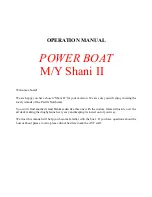
3/21/2017
Sabre 30 Owners Manual
31/81
angle of heel is exceeded, the traveler should be moved to leeward to reduce the heeling
moment, and the tension on the main sheet increased to flatten the sail. A very full
mainsail will give greatly increased weather helm. Adjust the hoist, foot and cunningham
for a flatter sail as the wind velocity increases.
GENOA: The optimum setting for the genoa is normally with the sail 2" to 4" off the
tip of the spreader. The genoa track block should be adjusted to provide a uniform luff
angle of attack from head to foot. Should the position of your genoa lead block on the
toerail be within one foot forward of the genoa winch, a great strain will be placed on
the toerail and block which will encourage toerail leaks. A genoa sheet turning block
bolted to the outboard side of the aft end of the winch island is recommended in such
cases.
SPINNAKER: The spinnaker pole should be set perpendicular to the apparent wind, in
approximately the same plane as the boom.
14:00 SAIL SELECTION (Cont'd)
SPINNAKER (Cont'd)
The outboard end of the spinnaker pole should be set to have the tack and clew of the
spinnaker at the same vertical height off the water which will vary according to the wind
velocity.
STORM JIB: A small jib with a full main will result in greatly increased weather helm
at substantial angles of heel. A more balanced reduction of the mainsail and jib sail
area is required to maintain the designed balance of the rig.
14:07 ANGLE OF HEEL WHILE SAILING: All Sabre yachts perform best at angles of heel
less than 25 degrees. Great angles of heel will result in extreme weather helm, leeway
(sliding leeward) and reduction in speed. This is typical of all boats of this general
design type. A convenient reference on Sabre 28, 30, and 34 is that the outermost six
inches of the cabin top, adjacent to the cabin sides, is at a slope of 25 degrees when
viewed from the cockpit. Therefore, the maximum angle of heel is readily identified when
this portion of the cabin top is parallel to the horizon. The Sabre will often appear to
be sailing faster at angles of heel greater than 25 degrees but our racing successes
indicates this is strictly an illusion. Experience has taught us that many Sabre owners
sail their boats at far greater angles of heel than this, with unsatisfactory results.
14:08 REDUCING SAIL AREA IN HEAVY WINDS: To insure safety and comfort in higher winds
it is important to build into your sail inventory the ability to reduce sail area quickly
and efficiently. Your local sailmaker can assist you with recommendations and
instructions on reducing sail area under varying conditions.
14:10 SAILMAKER FACT SHEET FOR SABRE 30 SLOOP
Hull Numbers for Various Models:
1. Series I hull numbers: 001 to 100
2. Series II hull numbers: 101 to present
Basic Rig Dimensions:
Series I: Series II:
P=34.80' I=40.08' P=36.30' I=41.58'
E=10.00' J=12.80' E=10.33' J=12.80'
Mainsail Data:
1. Main mast track
#6 metalmast flat internal slides
Summary of Contents for Sabre 30
Page 53: ...3 21 2017 Sabre 30 Owners Manual 53 81 STEERING WHEEL RUDDER AND WHEEL ASSEMBLY...
Page 55: ...3 21 2017 Sabre 30 Owners Manual 55 81 DECK HARDWARE RIGGING GENOA TRACK INSTALLATION...
Page 57: ...3 21 2017 Sabre 30 Owners Manual 57 81 DECK HARDWARE RIGGING CHAINPLATE ASSEMBLY...
Page 70: ...3 21 2017 Sabre 30 Owners Manual 70 81 WIRING DIAGRAMS LEGEND...
















































